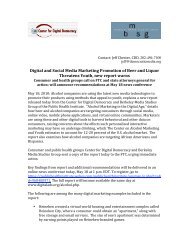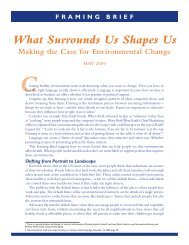"Interactive Food & Beverage Marketing" (PDF)
"Interactive Food & Beverage Marketing" (PDF)
"Interactive Food & Beverage Marketing" (PDF)
You also want an ePaper? Increase the reach of your titles
YUMPU automatically turns print PDFs into web optimized ePapers that Google loves.
<strong>Interactive</strong> <strong>Food</strong> & <strong>Beverage</strong> Marketing | The New Digital Marketing Landscape<br />
“Game-vertising”<br />
Of the more than 25 million 12-17 year-olds in the U.S., 20 million play interactive<br />
games, according to industry studies. 205 As research from the <strong>Interactive</strong> Advertising<br />
Bureau notes, “teens are tied for the most time spent playing online per week (13<br />
hours). 206 Gaming takes place across many digital platforms in addition to the Internet—<br />
from consoles, to hand-held devices such as Nintendo, to cell phones. Some of the<br />
biggest brands in the youth market, including Levis, Coke, McDonald’s, Kraft, Nike, AT&T<br />
Wireless, and Nokia, have been woven into the content of popular games. 207 “In-game<br />
advertising” (or “game-vertising”) has become such a profitable business that it has<br />
spawned a new generation of companies specializing in the creative integration of brands<br />
into interactive games. One of the biggest firms is Massive, a New York-based gaming network<br />
that has signed deals with dozens of U.S. advertisers, promising to integrate their<br />
products into games like Ubisoft’s “Splinter Cell: Chaos Theory” and Funcom’s “Anarchy<br />
Online.” 208 Microsoft—which owns Xbox and produces “Halo” and other popular games—<br />
recently paid several hundred million dollars to acquire Massive. In public statements,<br />
Microsoft executives framed the company’s move as a way to enhance the aesthetic quality<br />
of its games. “Massive’s solution,” a spokesperson told the press, “depicts brands in<br />
various forms within the game—on soft-drink cans and pizza boxes, on billboards and<br />
posters, and in images on TV screens—where gamers would expect to see them in real<br />
life, adding realism to the overall gaming experience.” 209<br />
But despite such claims to artistic “realism,” in-game advertising is, in fact, a<br />
highly sophisticated, finely tuned strategy that combines product placement, behavioral<br />
targeting, and viral marketing to foster deep, ongoing relationships between brands and<br />
individual gamers. Through “dynamic product placement,” Massive (whose clients have<br />
included Dunkin Donuts, Coke, Subway, and Wendy’s) enables advertisers not only to<br />
incorporate their brands into the game’s storyline but also to respond to a player’s<br />
actions in real time, changing, adding, or updating advertising messages to tailor their<br />
appeal to that particular individual. 210<br />
Fox’s IGA Worldwide, which offers advertisers “a surefire way to reach millions<br />
of consumers with high impact advertising and highly measurable results in some of the<br />
worlds leading game franchises,” recently announced the addition of Burger King to its<br />
client list. 211 The <strong>Interactive</strong> Advertising Bureau has released a “Marketer & Agency<br />
Guide to Online Game Advertising,” instructing companies on how they can engage in the<br />
practice, and identifying the different “models” for incorporating their brands into<br />
games. 212 A story in The Hollywood Reporter described the in-game targeting process:<br />
The technology makes it possible to change a campaign across dayparts,<br />
so that a food company, for example, could promote its coffee in<br />
the morning and snacks in the afternoon. Placement can be tailored<br />
according to consumer demography, game genre, behavioral data, daypart<br />
and other factors, and all aspects of the campaign can be<br />
changed across the network rapidly. 213<br />
49









